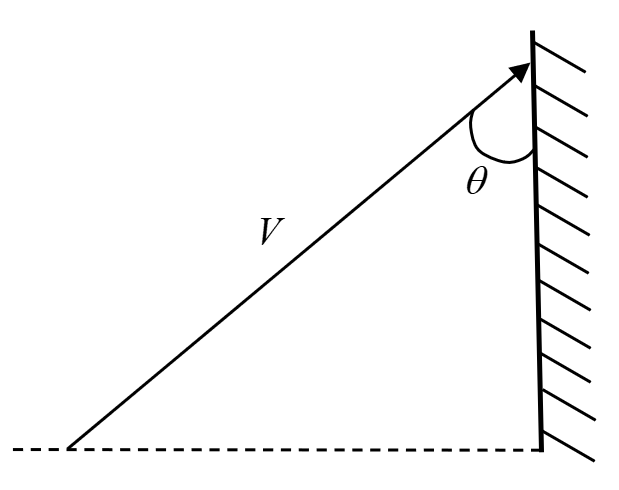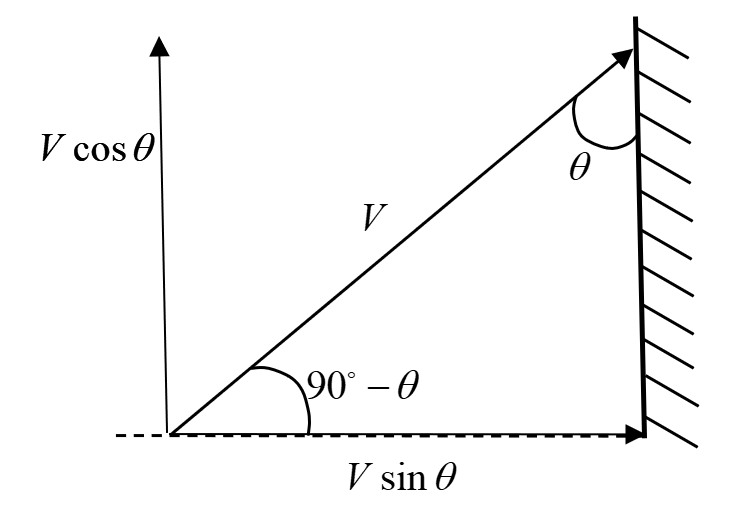
A person walks at a velocity $V$ in a straight line forming at an angle $\theta $ with the plane of a plane mirror. What is the relative velocity ${V_{{\text{rel}}}}$ with which he approaches the image?

A. $2V\sin \theta $
B. $2V$
C. $2V\cos \theta $
D. $\dfrac{V}{2}\sin \theta $
Answer
219.6k+ views
Hint: When the object moves towards a plane mirror, the velocity of the image is negative of that of the body, that is, $\mathop {{v_i}}\limits^ \to = - \mathop {{v_o}}\limits^ \to $ . When the object is moving parallel to the plane mirror, the velocity of the image is the same as that of the object, that is, $\mathop {{v_i}}\limits^ \to = \mathop {{v_o}}\limits^ \to $ .
Complete answer:
The vertical and horizontal components of the velocity of the person are as shown in the figure below:

Thus, the velocity of the person is given by:
$\mathop {{V_P}}\limits^ \to = - V\sin \theta \hat i + V\cos \theta \hat j$ … (1)
Now, we know that when the object moves towards a plane mirror, the velocity of the image is negative of that of the body, that is, $\mathop {{v_i}}\limits^ \to = - \mathop {{v_o}}\limits^ \to $ and when the object is moving parallel to the plane mirror, the velocity of the image is the same as that of the object, that is, $\mathop {{v_i}}\limits^ \to = \mathop {{v_o}}\limits^ \to $ .
Apply this concept on the vertical and horizontal components of the image velocity as well.
Let us first consider the vertical components,
In this case, the object is moving parallel to the mirror, therefore, $\mathop {{v_i}}\limits^ \to = \mathop {{v_o}}\limits^ \to $ .
Hence, vertical component of image velocity = vertical component of the velocity of the person
Thus, vertical component of image velocity $ = V\cos \theta $ … (2)
Now, let’s consider the horizontal components,
In this case, the object is moving towards the mirror, therefore, $\mathop {{v_i}}\limits^ \to = - \mathop {{v_o}}\limits^ \to $ .
Hence, horizontal component of image velocity = negative of the horizontal component of the velocity of the person
Thus, horizontal component of image velocity $ = V\sin \theta $ … (3)
Combining (2) and (3),
The velocity of the image, $\mathop {{V_I}}\limits^ \to = V\sin \theta \hat i + V\cos \theta \hat j$ … (4)
Now, velocity of the person with respect to their image, $\mathop {{V_{PI}}}\limits^ \to = \mathop {{V_P}}\limits^ \to - \mathop {{V_I} = }\limits^ \to - 2V\sin \theta \hat i$ .
The magnitude of this velocity is $2V\sin \theta $ .
Thus, the correct option is A.
Note: In the above question, we broke the components of the velocity of the object first. Then, we approached calculating the velocity of the image for each component in order to get our final answer.
Complete answer:
The vertical and horizontal components of the velocity of the person are as shown in the figure below:

Thus, the velocity of the person is given by:
$\mathop {{V_P}}\limits^ \to = - V\sin \theta \hat i + V\cos \theta \hat j$ … (1)
Now, we know that when the object moves towards a plane mirror, the velocity of the image is negative of that of the body, that is, $\mathop {{v_i}}\limits^ \to = - \mathop {{v_o}}\limits^ \to $ and when the object is moving parallel to the plane mirror, the velocity of the image is the same as that of the object, that is, $\mathop {{v_i}}\limits^ \to = \mathop {{v_o}}\limits^ \to $ .
Apply this concept on the vertical and horizontal components of the image velocity as well.
Let us first consider the vertical components,
In this case, the object is moving parallel to the mirror, therefore, $\mathop {{v_i}}\limits^ \to = \mathop {{v_o}}\limits^ \to $ .
Hence, vertical component of image velocity = vertical component of the velocity of the person
Thus, vertical component of image velocity $ = V\cos \theta $ … (2)
Now, let’s consider the horizontal components,
In this case, the object is moving towards the mirror, therefore, $\mathop {{v_i}}\limits^ \to = - \mathop {{v_o}}\limits^ \to $ .
Hence, horizontal component of image velocity = negative of the horizontal component of the velocity of the person
Thus, horizontal component of image velocity $ = V\sin \theta $ … (3)
Combining (2) and (3),
The velocity of the image, $\mathop {{V_I}}\limits^ \to = V\sin \theta \hat i + V\cos \theta \hat j$ … (4)
Now, velocity of the person with respect to their image, $\mathop {{V_{PI}}}\limits^ \to = \mathop {{V_P}}\limits^ \to - \mathop {{V_I} = }\limits^ \to - 2V\sin \theta \hat i$ .
The magnitude of this velocity is $2V\sin \theta $ .
Thus, the correct option is A.
Note: In the above question, we broke the components of the velocity of the object first. Then, we approached calculating the velocity of the image for each component in order to get our final answer.
Recently Updated Pages
Electricity and Magnetism Explained: Key Concepts & Applications

JEE Energetics Important Concepts and Tips for Exam Preparation

JEE Isolation, Preparation and Properties of Non-metals Important Concepts and Tips for Exam Preparation

JEE Main 2021 July 25 Shift 1 Question Paper with Answer Key

JEE Main 2021 July 22 Shift 2 Question Paper with Answer Key

States of Matter Chapter For JEE Main Chemistry

Trending doubts
Understanding Uniform Acceleration in Physics

Understanding Atomic Structure for Beginners

Understanding Centrifugal Force in Physics

JEE Main Marking Scheme 2026- Paper-Wise Marks Distribution and Negative Marking Details

Degree of Dissociation: Meaning, Formula, Calculation & Uses

Understanding Average and RMS Value in Electrical Circuits

Other Pages
Understanding Entropy Changes in Different Processes

Common Ion Effect: Concept, Applications, and Problem-Solving

Formula for number of images formed by two plane mirrors class 12 physics JEE_Main

JEE Main 2025-26 Mock Test: Ultimate Practice Guide for Aspirants

Understanding Excess Pressure Inside a Liquid Drop

CBSE Class 10 Sanskrit Set 4 52 Question Paper 2025 – PDF, Solutions & Analysis




